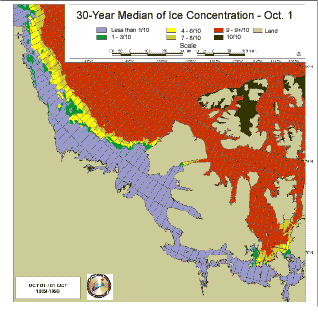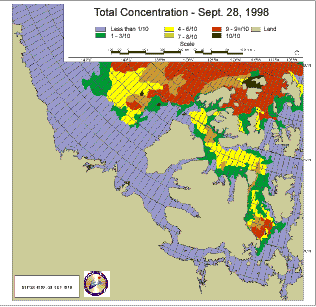| ||||||||||||||||||||||||||||
Proactive disclosure Print version |  Taking the Chill Off: Climate Change in the Yukon and Northwest Territories Impacts of Climate Change in the Beaufort Sea Region Significant segments of the western Arctic coast are subject to rapid rates of change. More than 10 m of erosion can occur in a single year in the Beaufort Sea region. Climate warming will be accompanied by increased thaw of coastal permafrost and slope failure. The changes may pose hazards to navigation and offshore resource development and also affect coastal communities and their use of coastal resources. 
Communities and Coastal Erosion Tuktoyaktuk is the primary transportation hub for the western Arctic coast. Situated on the coast of the Beaufort Sea, it has experienced erosion problems almost since its establishment in 1934. Severe storms and very little ice in 1944, 1970, 1993 and 2000 resulted in major episodes of erosion. The curling rink was undermined and destroyed in the 1980s and the school was closed and torn down in the 1990s. Climate change may increase the frequency of damaging storms because of decreases in the amount of ice in the area during the summer and possible changes in storm intensity or frequency. Rising sea level will have long term impacts as well.
The air photo of Tuktoyaktuk at the top was taken in 1947. The black line represents the position of the shoreline in 1997 and the green line shows the shoreline in 1974. Severe erosion has occurred in this section of the peninsula. The photo that was taken in 1998 shows the newly installed shore protection. This is the third attempt at shore protection since 1976. The Hamlet plans to completely protect the coast between the spits. Sea Ice and Marine Mammals A consequence of climate warming is a decrease in the extent of Arctic sea ice and an increase in the length of the melt season. The strong El Ni˝o conditions in 1997-1998 resulted in record high temperatures in the Canadian Arctic that restricted ice growth and enhanced melt. The extent of sea ice in 1998 therefore was much less than normal.   When break up of the land fast ice (sea ice along the coast) is early, the lactation period for seal pups at the edge of the breeding habitat may be interrupted. Mother-pup pairs depend on the stable ice for their lairs, for a successful (typically 6 week) nursing period. In 1998, break-up of the sea ice was approximately 3 weeks early in the Beaufort Sea region, and this probably led to an abrupt end of the nursing period. However only those pups that were unfortunate enough to be at the edge of the breeding habitat would have been affected by this event. Wasted, skinny and stunted seal pups were found, by scientists and seal hunters. By examining the stomach contents of these pups, it was found that they had been attempting to feed themselves (invertebrates and Arctic cod), but at an earlier stage than usual. It is not known if these unweaned pups would have survived or not, nor do we know the long-term consequences of the early break up of the sea ice on the seal population. The range of conditions of seal pups in 1998 is shown below.
Possible effects of climate warming on polar bears in the Beaufort Sea region have not yet been documented. Although the ice breaks up earlier now than in previous years, the bears can still move with the sea ice to areas where they are able to feed on seals. However, if earlier breakup results in a reduction in the number of young seals born in the spring, or their survival, this will in turn be reflected in poorer condition and lower reproduction of polar bears, as was demonstrated in the mid-1970s when the productivity of ringed seals declined significantly for about 3 years. Credits: Agnew, T., 1999. The record reduction of ice in the Canadian Arctic islands and western Arctic Ocean in 1998; CRYSYS web site, Environment Canada, www.msc-smc.ec.gc.ca/crysys/science/documents/seaice_summer98.html Harwood, L.A., Smith, T.G. and Melling, H., 2000. Variation in reproduction and body condition of the ringed seal (Phoca hispida) in western Prince Albert Sound, NT, Canada, as assessed through a harvest-based sampling program. Arctic 53 (4), in press. Solomon, S., Geological Survey of Canada - Atlantic, pers. comm. Stirling, I., Canadian Wildlife Service, pers. comm. Links to other web sites featuring information on the Beaufort Sea Region:
|